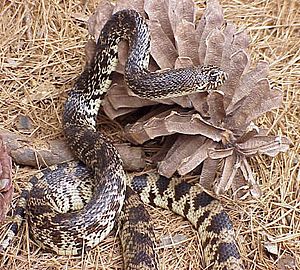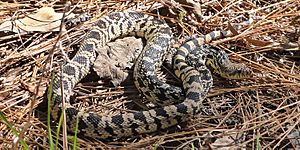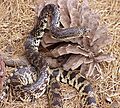Louisiana pine snake facts for kids
Quick facts for kids Louisiana pine snake |
|
|---|---|
 |
|
| Conservation status | |
| Scientific classification | |
| Genus: |
Pituophis
|
| Species: |
ruthveni
|
| Synonyms | |
|
|
The Louisiana pine snake (Pituophis ruthveni) is a large, non-venomous snake. It is a constrictor, meaning it squeezes its prey. This powerful snake is special because it lays very large eggs, but only a few at a time.
This snake lives in west-central Louisiana and East Texas. It depends a lot on Baird's pocket gophers. These gophers dig burrows that the snakes use for shelter and as a main food source. The Louisiana pine snake is very hard to find in the wild. It is one of the rarest snakes in North America.
This snake became so rare because it has few babies and its home, the longleaf pine forests, has been largely destroyed. People are now working hard to help this snake recover. About 300 snakes have been released back into the wild. In 2018, the snake was added to the list of endangered and threatened animals. A rule made in 2020 means that bothering these snakes can lead to serious consequences.
Contents
About the Louisiana Pine Snake's Name
This snake was first described in 1929 by Olive Griffith Stull. She first thought it was a type of P. melanoleucus snake. Later, in 1940, Stull decided it was its own unique species. Its scientific name, ruthveni, honors Alexander Grant Ruthven. He was a herpetologist (someone who studies reptiles and amphibians) from the University of Michigan Museum of Zoology.
What the Louisiana Pine Snake Looks Like
The Louisiana pine snake has a buff or yellowish color on its back. It has dark brown blotches and spots that are similar all over its body. The patterns look a bit different from its head to its tail. Near its neck, the dark marks blend more with the lighter color.
Towards the middle of its body, the dark markings become clearer. They stay clear towards the tail, but get thinner. There are usually 28 to 42 of these markings along its back. Its pointed head might have only a few small dots. The scales on its belly are not plain; they have brown blotches. The scale on its nose is very large.
Growth and Life Cycle
Louisiana pine snakes grow quickly. They can reach about 2 to 3 feet (60-90 cm) long by one year old. By two years old, they can be 3 to 4 feet (90-120 cm) long. The longest one ever found was about 5.8 feet (177 cm) long.
They can start having babies when they are at least 3 years old and about 4 feet (120 cm) long. These snakes lay eggs. The eggs develop inside the mother for about 21 days. Then, after the eggs are laid, they hatch in about 60 days.
This snake has a very low number of babies. It lays the smallest number of eggs (three to five) of any snake in North America. However, its eggs are the largest of any snake in the United States. They are usually about 5 inches (13 cm) long and 2 inches (5 cm) wide. The baby snakes are also very big when they hatch, about 18 to 22 inches (46-56 cm) long. Their large size might help them start eating earlier.
Snake Behavior
Studies in East Texas and western Louisiana show that these snakes spend most of their time (at least 60%) underground. They only move short distances, about 10 to 20 feet (3-6 meters), when they are underground. Snakes were most active in the late morning and afternoon. They were least active at night and early morning.
When above ground, snakes usually went back underground at least once during the day. They might do this to find food, cool down, or hide from predators. When they hibernate (sleep for the winter), they always use pocket gopher burrows.
Louisiana pine snakes are most active from March to May and in the fall, especially November. They are least active during hibernation from December to February, and in the summer, especially August. Their underground homes are almost always the burrows of Baird's pocket gophers. Pocket gophers also seem to be their main food. However, they also eat other rodents, cottontail rabbits, amphibians, and ground-nesting birds and their eggs.
The area a snake uses in a year can vary from 12 acres (5 hectares) for young snakes to 195 acres (79 hectares). On average, they use about 69 acres (28 hectares). Adult male snakes use larger areas (145 acres or 59 hectares) than females (25 acres or 10 hectares).
Pine snakes in East Texas usually move less than 33 feet (10 meters) each day. But when they move longer distances, usually to a new gopher burrow system, they travel much farther. Adult females moved about 669 feet (204 meters) daily, and adult males moved about 568 feet (173 meters). In Louisiana, males moved about 492 feet (150 meters) on average, and females about 344 feet (105 meters). Males tended to make long moves from May to July, while females moved mostly from July to September. They do not seem to migrate seasonally.
Where the Snake Lives
The Louisiana pine snake usually lives in sandy, well-drained soils. It prefers open pine forests, especially longleaf pine savannas. These areas have few medium-sized trees and many grasses and plants on the ground.
Baird's pocket gophers are a very important part of their home. The gophers dig the burrows where the snakes are often found. They are also a major food source. Up to 90% of the time, scientists found radio-tagged snakes underground in gopher burrows. Snakes that were disturbed on the surface would quickly go into nearby burrows. Hibernation spots were always in burrows. Both wild and captive-released snakes were found most often in areas with many gopher mounds. Snakes stayed active longer and moved more where gopher burrows were common.
Many pocket gophers live where there are lots of grassy plants and loose, sandy soil. The amount of grassy plants depends on how much sunlight reaches the forest floor. A rich ground layer needs a lot of sun. Many gophers were found where there were fewer trees and an open tree canopy. This allowed more sunlight, more plants growing under the trees, and better food for the gophers.
Where They Are Found and Their Status
Louisiana pine snakes used to live in at least 9 parishes in Louisiana and 14 counties in East Texas. This area was part of the longleaf pine ecosystem west of the Mississippi River. Now, they are found in only four Louisiana parishes and at most five Texas counties.
In Texas, recent records show them only in the southern part of the Sabine National Forest (Sabine County) and nearby private land (Newton County). They are also in the southern part of Angelina National Forest and nearby private timberland (Angelina, Jasper, Tyler Counties). Most Louisiana records are from Bienville Parish on private forestland. Another group lives on federal lands in Vernon Parish (Fort Johnson, U.S. Army, and Kisatchie National Forest). A third group seems to be near where Vernon, Sabine, and Natchitoches Parishes meet.
The number of Louisiana pine snakes has dropped a lot in the last 50 to 80 years. Many local groups of snakes have disappeared. A study of places where they used to live found that only 34% of those areas could still support a healthy snake population. The snake has not been seen in over ten years in some of the best remaining places it used to live. This suggests they might be gone from those areas or are extremely rare. It is now known as one of the rarest snakes in North America. It is also one of the rarest animals with backbones in the United States.
Threats to the Louisiana Pine Snake
Several things threaten the Louisiana pine snake.
Loss of Habitat
Building cities, turning land into farms, building roads, and mining have all caused the snake's home to shrink and break into smaller pieces. People catching snakes for pets might also have hurt their numbers. However, the biggest problem has been the loss of the natural longleaf and shortleaf pine forests.
Almost all the timber in the South was cut down between 1870 and 1920. By 1935, only 3% of the original longleaf pine forests in Louisiana and Texas were left untouched. By the 1980s, only 15% of the 1935 levels in Louisiana and 7% in Texas of these natural forests remained. Most of these historic forests have been replaced with plantations of fast-growing loblolly and slash pine trees. These tree farms are usually very dense and are cut down quickly, in less than 40 years. These forests have very few plants growing on the ground, making them unsuitable for pocket gophers.
Fire Suppression
Any pine habitat that is left is often in isolated areas. It is also often damaged because natural wildfires are stopped. Stopping natural fires might be the biggest threat to the Louisiana pine snake in recent years. This reduces both the amount and quality of places where pine snakes can live.
The longleaf pine savanna forest developed with frequent, but low-intensity, ground fires. These natural fires on sandy soils usually kept the forest open. They allowed longleaf pine trees to grow, with few medium-sized trees, but many native grasses and plants on the ground. These park-like forests were perfect homes for pocket gophers, and thus for pine snakes.
Without regular fires, these upland pine forests quickly grow a dense layer of medium-sized trees. This stops or removes the plants growing on the ground. Since the number of pocket gophers is directly linked to how many plants they can eat, their numbers drop when these plants disappear. No pine snakes have been found in areas badly affected by fire suppression. Pine snakes are actually well-suited to fire. Snakes above ground quickly move into pocket gopher burrows when flames get close. Nine pine snakes living in areas that had controlled burns over three years all survived without any harm.
Vehicle Accidents
Louisiana pine snakes are also hurt by vehicles. This happens on state roads and on off-road trails. Researchers have seen three snakes killed by vehicles, including off-road vehicles. Roads with a lot of traffic can reduce populations of large snakes by 50-75% for up to 2800 feet (853 meters).
Known problems between pine snakes and vehicles exist in parts of the Longleaf Ridge Area of Angelina National Forest. Vehicles have destroyed a large part of some plant communities there. In Sabine National Forest, vehicle problems happen in other specific areas.
Helping the Louisiana Pine Snake Recover
Animals that have few babies, like the Louisiana pine snake, usually cannot recover quickly from things that reduce their numbers. This makes them more likely to disappear from an area. The survival of the Louisiana pine snake depends on the Baird's pocket gopher. The gopher's numbers, in turn, depend on the plants and loose, sandy soil of the longleaf pine savannas.
In March 2004, eight state and federal groups signed an important agreement. This agreement helps protect the Louisiana pine snake on federal lands in Texas and Louisiana. The groups working together include Fort Johnson Military Installation, Kisatchie National Forest, National Forests in Texas, Louisiana Department of Wildlife and Fisheries, Texas Parks and Wildlife Department, United States Fish and Wildlife Service, and United States Forest Service. This agreement allows these groups to work together to avoid and reduce harm to the snake. It also helps them share information about successful ways to manage the snake and coordinate research.
Using fire is a key part of the recovery effort. The actions planned by these groups are meant to bring back and protect the remaining longleaf pine forests in East Texas and western Louisiana. Frequent, low-intensity ground fires are needed to keep these forests open. Many of the plants in these forests actually need to be burned to reproduce or grow. Longleaf pine forests are very special places. They are among the most diverse ecosystems outside of tropical areas. Over 30 plant and animal species that live in longleaf pine ecosystems are endangered or of concern.
The American Zoo and Aquarium Association helps manage a Species Survival Plan for the Louisiana pine snake. This plan is based at the Memphis Zoo. The Species Survival Plan makes sure that the valuable captive population of snakes in zoos, which is less than 100 individuals, is managed carefully for the long term.
Releasing captive snakes has led to about 300 being set free in the wild. The Fish and Wildlife Service officially listed the Louisiana pine snake as an endangered and threatened animal on May 7, 2018. A special rule means that interfering with this species can lead to serious consequences.
Images for kids





